Interannual Variations in Synoptic-Scale Disturbances over the Western North Pacific
Xingyan ZHOU,Riyu LU?,Guanghua CHEN,and Liang WU
1State Key Laboratory of Numerical Modeling for Atmospheric Sciences and Geophysical Fluid Dynamics,Institute of Atmospheric Physics,Chinese Academy of Sciences,Beijing 100029,China
2University of the Chinese Academy of Sciences,Beijing 100049,China
3Center for Monsoon System Research,Institute of Atmospheric Physics,Chinese Academy of Sciences,Beijing 100029,China
1.Introduction
Synoptic disturbances are predominant over the western North Pacific(WNP)during the warm season.They are an important rainfall system,contributing to a large portion of total precipitation in the WNP and the South China Sea(SCS)(Hurley and Boos,2015).In addition,synoptic disturbances are significant precursors to the formation of tropical cyclones,and it is estimated that more than half of tropical cyclones occurring over the WNP are triggered by synoptic disturbances(Fu et al.,2007;Chen and Huang,2009;Xu et al.,2013;Chen and Chou,2014).Therefore,synoptic disturbances greatly affect the weather and climate of East Asia and Southeast Asia through landing disturbances and tropical cyclones(e.g.,Chen et al.,2012).
The development of synoptic disturbance is strongly affected by the interaction with background circulations.It has been indicated that con fluent flows have an important impact on the amplification of synoptic disturbances(e.g.,Webster and Chang,1988;Kuo et al.,2001).Over the WNP,a confluence zone exists between the lower-level easterly trade winds and westerly monsoonal winds, i.e., the monsoon trough,during summer and autumn,and thus the monsoon trough contributes greatly to the growth of synoptic disturbance(Sobel and Bretherton,1999;Wu et al.,2012,2015a;Molinari and Vollaro,2013).Besides,intraseasonal oscillations can also modulate synoptic disturbance.During the active phases of intraseasonal oscillations,synoptic disturbances over the WNP are considerably stronger(Maloney and Hartmann,2001;Maloney and Dickinson,2003;Hsu et al.,2011;Cao et al.,2012;Tsou et al.,2014).
From the interannual aspect,many studies have documented that ENSO can affect synoptic disturbance activity over the WNP through modulating large-scale circulations.For example,Hsu et al.(2009)revealed that during warm ENSO years the activity of synoptic disturbance is enhanced from the Philippine Sea to the date line,as compared to that during cold years.Wu et al.(2014)investigated the structure and evolution of synoptic waves related to ENSO,and found that during El Ni?o summers the tropical depression(TD)and mixed Rossby–gravity wave(MRG)appear with equivalent barotropic structure,and the transition from MRG to TD is clear.In contrast,during La Ni?a summers the vertical structure of TD-MRG waves becomes tilted eastward with height,and the MRG-to-TD transition is unclear.Additionally,ENSO may affect synoptic disturbance activity through modulating the location and strength of monsoon trough in the WNP.During El Ni?o(La Ni?a)years,the monsoon trough extends eastward(retreats westward)and becomes stronger(weaker),resulting in enhanced(reduced)disturbance activities over the southeastern quadrant of the WNP(Chan and Liu,2004;Li and Zhou,2012;Wu et al.,2012,2015a).
In this study,we begin with the features of interannual variation in synoptic disturbances,rather than regarding the interannual variation as a result of ENSO impacts.From the viewpoint of the interannual variation,the following questions arise:What are the features and dominant modes of the interannual variations of synoptic disturbances?Are there any other factors, other than ENSO, significantly affecting the interannual variations of synoptic disturbances?If yes,what kind of mechanism is responsible for the impact?Answering these questions is the main motivation in this study.
The rest of this paper is organized as follows:Section 2 introduces the datasets and analysis methods.The features of the annual cycle and interannual variation of synoptic disturbances over the WNP are presented in section 3.Section 4 shows the atmospheric circulations associated with the interannual variation of synoptic disturbance activity.Barotropic energy conversion is analyzed in section 5 to examine the interaction between the dominant modes and large-scale cir-culation anomalies.Finally,conclusions are given in section 6.
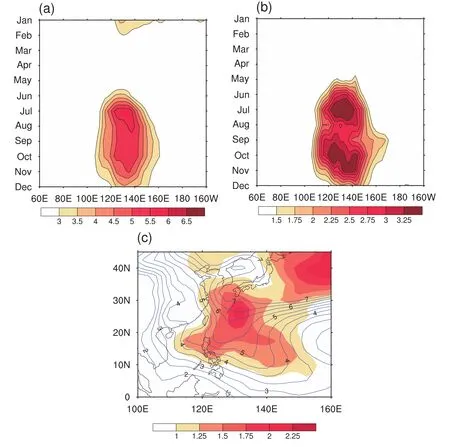
Fig.1.Annual cycles of the(a)climatological mean and(b)interannual standard deviation of 850-hPa EKE averaged over 10°–20°N.(c)Climatological mean(contours)and standard deviation(shading)of EKE averaged over June–November.Units:m2s?2.
2.Data and methods
The daily and monthly horizontal winds are from the NCEP–NCAR reanalysis dataset.These data have a horizontal resolution of 2.5°×2.5°and span from 1958 to 2014.The SST data are from ERSST.v2,with a horizontal resolution of 2°×2°.The Ni?o3.4 index is defined as the SST anomalies averaged over the region(5°S–5°N,120°–170°W).
EOF analysis is performed to determine the dominant modes of interannual variability of synoptic disturbance activity over the WNP.The Butterworth filter is applied to isolate synoptic disturbance with a period of 3–8 days.The strength of synoptic disturbance activity is measured by the 850-hPa eddy kinetic energy(EKE),

where an overbar denotes the average over June–November,andu′andv′represent the synoptic zonal and meridional velocities,respectively.
3.Features of the annual cycle and interannual variations
In order to display the annual cycle of synoptic disturbance activity,Fig.1a shows a longitude–time Hovm¨oler diagram of EKE averaged over 10°–20°N.The maximum synoptic disturbance activity occurs during summer and autumn over the region 110°–150°E,and reaches a peak in July and August,which is consistent with previous studies(Serra et al.,2008;Huang and Huang,2011;Fukutomi et al.,2016).Figure 1b shows the annual cycle of the meridional mean(10°–20°N)interannual standard deviation of synoptic disturbances,which is used to represent the amplitude of interannual variation.Similar to the results shown in Fig.1a,the prominent interannual variation appears from June to November in the WNP region.We also examined the spatial distribution for the climatological mean and interannual standard deviation of 850-hPa EKE for each month from January to December(not shown),and found that the EKE and its variability are strong over the tropical and subtropical WNP in summer and autumn,and are distinguishable from the storm track over the North Pacific.Therefore,we select the period from June to November as the object of this study.The horizontal distributions of the climatological mean and interannual standard deviation of EKE over June–November are shown in Fig.1c.The regions with a large climatological mean and interannual standard deviation are roughly consistent.The strong standard deviation over the subtropical WNP is distinct from the strong midlatitude standard deviation associated with the storm tracks over the North Pacific.
To capture the spatial mode of synoptic disturbances,we perform an EOF analysis on the 850-hPa EKE averaged over June–November in the domain(0°–35°N,100°–160°E)during 1958–2014.The first two modes account for 32.3%and 18.1%of the total variance,respectively,and both are independent according to the criteria of North et al.(1982).These two leading modes explain more than half of the total variance.

Fig.2.Regression of 850-hPa EKE with respect to the normalized(a)PC1 and(b)PC2,and the normalized(c)PC1 and(d)PC2,performed by EOF analysis.In(a,b),dots denote regions significant at the 95%confidence level.Units:m2s?2.
The first mode(EOF1)is characterized by a northwest–southeast-oriented pattern over the WNP(Fig.2a).The second mode(EOF2)is also characterized by a northwest–southeast-oriented positive anomaly(Fig.2b),which is located around the Philippines and with its center shifted more southwestward in comparison with the first mode.In addition,there is a negative anomaly to the east of the positive anomaly,but with a weak amplitude.According to the spatial distributions,we refer to these two modes as the northeast pattern and southwest pattern,respectively.The principal components(PC1 and PC2)do not show an appreciable long-term trend or decadal variation(Figs.2c and d).
Figure 3 displays the ratios of the total variance explained by these two leading modes in each grid.As expected from the EOF results shown in Fig.2,the first mode contributes greatly over the WNP,with a maximum larger than 60%of the total variance;whereas,the second mode contributes greatly around the Philippines,explaining about 80%of the total variance over this region.Although the first and second modes explain the main variance over these distinct regions,the combined contribution of the two modes is manifested as a unified pattern(Fig.3c).These two leading modes together explain more than 60%of the total variance over a broad area of the WNP.This indicates that the interannual variability of synoptic disturbance activity can be explained well by these two leading modes.
4.Large-scale circulation anomalies associated with the dominant modes
Figure 4 shows the regression of 850-hPa horizontal winds with respect to the normalized PC1 and PC2.The northeast pattern,the first mode,is related to a significant cyclonic anomaly over the subtropical WNP(Fig.4a).On the other hand,the southwest pattern,the second mode,is associated with a significant cyclonic anomaly centered over the SCS(Fig.4b).Furthermore,both the northeast and southwest patterns are related to a significant zonal wind anomaly over the equatorial Pacific:a westerly anomaly for the former pattern but an easterly anomaly for the latter pattern.
Figure 5 shows the correlation coefficients between the Ni?o3.4 index and interannual variation of synoptic disturbance activity over the WNP and SCS.The correlation coefficients are positive over the WNP and negative around the Philippines.These positive and negative correlation coefficients resemble the northeast and southwest patterns,respectively,although the negative ones extend to the equator where the EKE shows weak interannual standard deviation(Fig.1c).These correlation coefficients confirm the close relationship between ENSO and the synoptic disturbance activities over the WNP and SCS,and suggest a close relationship between ENSO and the two leading modes.Actually,the correlation coefficient between the Ni?o3.4 index and PC1(PC2)is 0.43(?0.44),both being significant at the 99%confidence level.
However,the correlation coefficients shown in Fig.5 indicate that the majority of the interannual variance of synoptic disturbance activity cannot be explained by ENSO.In contrast,the ENSO-related atmospheric circulation anomalies may be confused with the circulation anomalies associated with the interannual variation of synoptic disturbance activity.Therefore,we remove the effect of ENSO and investigate the circulation anomalies associated with the residual component of the interannual variation of synoptic disturbance activity.We first compute the ENSO-related components through linear regression onto the Ni?o3.4 index,and then remove them from original data.
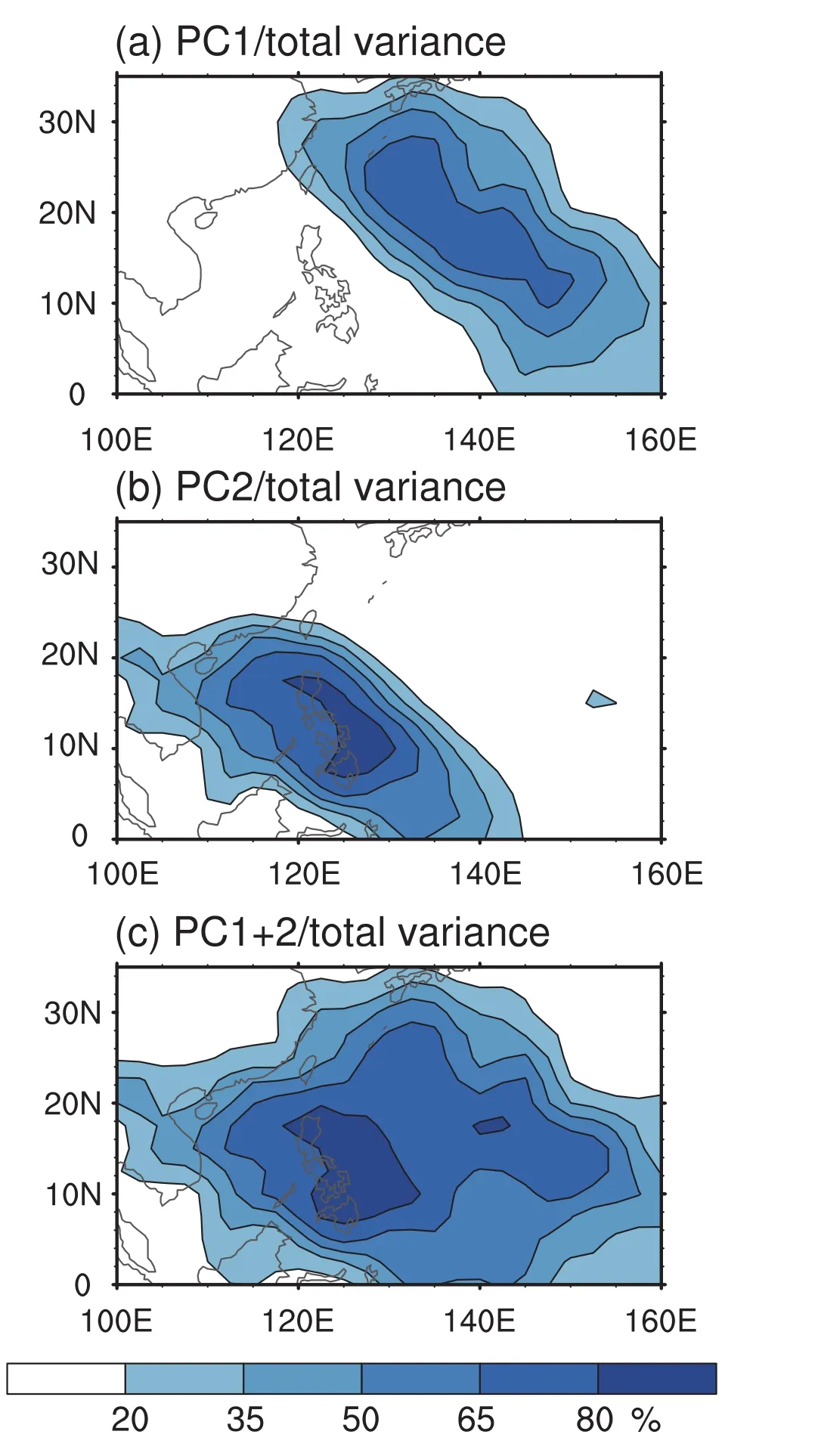
Fig.3.Ratios of the total variance explained by the(a) first mode,(b)second mode,and(c)both leading modes,for each grid.

Fig.4.Regression of 850-hPa horizontal winds with respect to the normalized(a)PC1 and(b)PC2.Shading denotes regions of either zonal or meridional wind anomalies significant at the 95%confidence level.Units:m s?1.
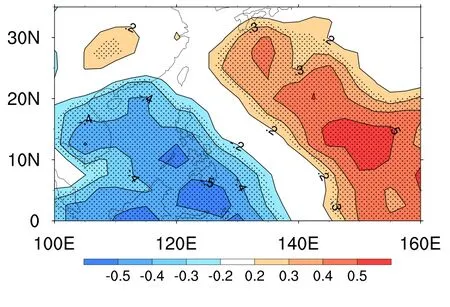
Fig.5.Correlation coefficients between 850-hPa EKE and the Ni?o3.4 index.Dots denote regions significant at the 95%confidence level.
Figure 6 shows the EOF results after removing the effect of ENSO.Their distributions are similar to those of the original field shown in Fig.2.The first mode still displays a positive anomaly over the WNP(Fig.6a).The second mode is characterized by a positive anomaly around the Philippines and a weak negative anomaly to its east(Fig.6b).The differences in the amplitudes of these anomalies derive from the positive anomalies in the two modes becoming slightly weaker,and the negative anomalies for the second mode becoming slightly stronger,after the removal of the ENSO-related component.
For convenience of description,the principal components of these two ENSO-removed modes are termed PC1_denso and PC2_denso,respectively.The correlation coefficient between PC1_denso/PC2_denso and the Ni?o3.4 index is 0.005/0.010,suggesting the method for removing the effect of ENSO is valid.The correlation coefficient between PC1_denso(PC2_denso)and PC1(PC2)is 0.88(0.80).The high correlation coefficients in the PCs and the similarity in the EOF distribution indicate that,after eliminating the effect of ENSO,the leading modes still maintain the major characteristics of the northeast and southwest patterns.
Figure 7 shows the ratios of the total variance explained by PC1_denso and PC2_denso.Here,the total variance is obtained by the original data.The ratios are similar to those explained by PC1 and PC2 shown in Fig.3,despite a slight decrease in amplitude.These results con firm that the northeast and southwest patterns are still robust without the effect of ENSO and can explain most of the interannual variability in synoptic disturbances.This is expected considering ENSO explains less than 20%of the total variance of PC1/PC2,implied by the correlation coefficient between the Ni?o3.4index and PC1/PC2(0.43/?0.44).
Figure 8 shows the regression of 850-hPa horizontal winds with respect to the normalized PC1_denso and PC2_denso.In comparison to Fig.4,in both the northeast and southwest patterns an apparent difference is that the zonal wind anomalies over the equatorial Pacific become much weaker and are con fined to the western Pacific due to the elimination of the ENSO effect.On the other hand,the anomalous cyclone appears over the WNP in the northeast pattern and over the Philippines in the southwest pattern,although their strengths are weaker than those obtained by the original data(Fig.4).
5. Energy analysis of the interaction between the dominant modes and circulation anomalies
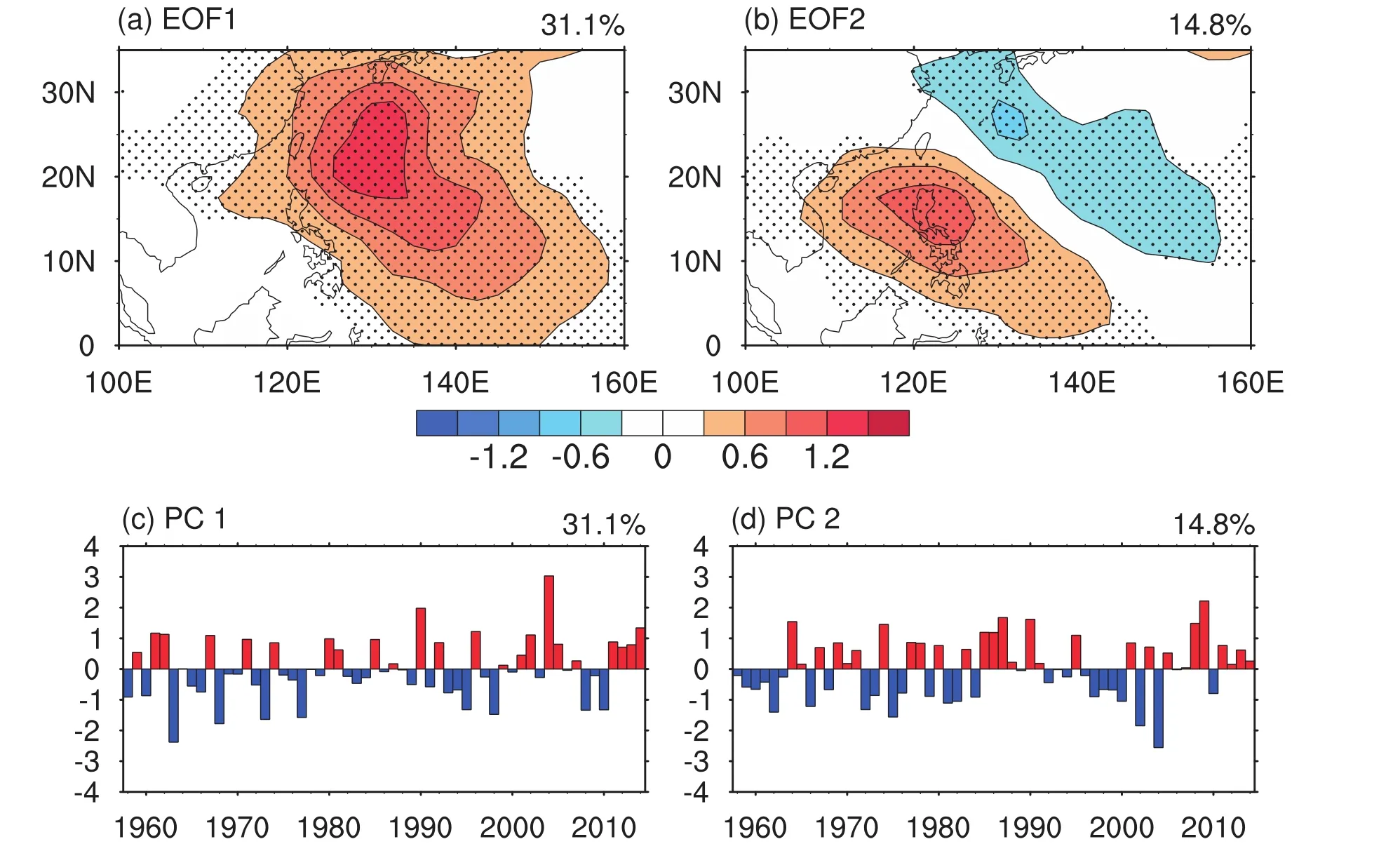
Fig.6.As in Fig.2 but after removing the effect of ENSO.
The EKE balance equation has been widely used to diagnose the energy source and redistribution,and the barotropic conversion can be used to illustrate the energy transfer between the mean flows and eddies(e.g.,Lau and Lau,1992;Maloney and Hartmann,2001;Chen and Huang,2009).Therefore,in the following,the barotropic conversion is analyzed to illustrate the role of large-scale circulation anomalies in affecting synoptic disturbances.The EKE tendency related to the barotropic energy conversion can be expressed in the following form:

Here,K,uandvrepresent kinetic energy and zonal and meridional velocities,respectively.The overbar denotes the June–November mean for one specified year,and the prime denotes synoptic perturbation.The first and fourth terms are determined by the perturbation momentum flux and horizontal mean flow shear,and the second and third terms are determined by the perturbation intensity and mean flow convergence.
After calculating the barotropic energy conversion for each year,we perform the regression with respect to the normalized PC1_denso and PC2_denso.The zonal–vertical cross sections of regressed anomalies along the subtropics(such as 10°–25°N)indicate that the maximum values appear at 850 hPa(not shown),which is consistent with previous studies(Lau and Lau,1992;Hsu et al.,2009;Tsou et al.,2014).Therefore,we select this pressure level to show the horizontal distribution of regressed anomalies.
Figures 9a and b show the regression of barotropic energy conversion at 850 hPa with respect to the normalized PC1_denso and PC2_denso.There is a significant positive anomaly over the Philippine Sea for the northeast pattern(Fig.9a),indicating that the mean flow tends to transfer more kinetic energy to the perturbation flow over this region when PC1_denso is positive.Therefore,we can conclude that,for a positive northeast pattern,synoptic disturbances obtain energy from the mean flow over the Philippine Sea and propagate northwestward,leading to strong EKE over the Philippine Sea and the subtropical WNP(Fig.6a).For the southwest pattern,the maximum barotropic energy conversion is shifted westward,occurring around the Philippines,and with a negative anomaly over the Philippine Sea(Fig.9b).The positive anomaly is twice as large as the negative one.These distributions of barotropic kinetic energy conversion are similar to those of the corresponding leading modes.This indicates that the barotropic conversion plays a crucial role in inducing the leading modes.To facilitate comparison,we also show the regression of barotropic energy conversion at 850 hPa with respect to the normalized PC1 and PC2,i.e.,the original time series of the PCs,in Figs.9c and d.Their distributions are similar to those of PC1_denso and PC2_denso,albeit with a slight increase in amplitude. This indicates that the circulation anomalies shown in Fig.8 can sustain the leading modes through barotropic energy conversion,although their strength becomes weaker after the removal of the ENSO effect.

Fig.7.Ratios of the total variance explained by(a)PC1_denso,(b)PC2_denso,and(c)both PC1_denso and PC2_denso.
Figure 10 depicts the regression of four barotropic conversion terms with respect to the normalized PC1_denso and PC2_denso.It is clearly shown that,for both the northeast and southwest patterns,the first term[?u′v′(?uˉ/?y)]exhibits the largest magnitude among all conversion terms,and its distribution is very similar to the total barotropic energy conversion(Figs.9a and b).This term is determined by the meridional shear of mean zonal flow(??uˉ/?y)and the momentum transport of synoptic disturbance(u′v′).The momentum transport(u′v′)is positive because synoptic perturbations over the WNP feature northeast–southwest orientation(e.g.,Chen and Huang,2009).Therefore,the sign of the first term is decided by the meridional shear of the zonal wind.For the northeast pattern,there is a cyclonic circulation,i.e.,?(?uˉ/?y)>0,over the Philippines Sea(Fig.8a),leading to a positive conversion anomaly over this region(Fig.10a).The first term related to the southwest pattern shows a positive anomaly over the Philippines and a relatively weak negative anomaly to the east(Fig.10b).This distribution of barotropic conversion anomalies can also be explained by the meridional shear of zonal wind,which is characterized by the cyclonic anomaly over the SCS and the anticyclonic anomaly to the east(Fig.8b).
The second term[?u′2(?uˉ/?x)]shows a distribution somewhat similar to that of the first term for both the northeast and southwest patterns(Figs.10c and d),suggesting this term also partly contributes to the total barotropic conversion.However,the amplitude in this term is smaller than that in the first term,and tends to be opposite to that in the third term[?v′2(?vˉ/?y)](Figs.10e and f).The fourth term[?u′v′(?vˉ/?x)]is very small and can be neglected(Figs.10g and h).
Therefore,we can conclude that the first term is dominant—that is,the cyclonic shear of the zonal wind is key to the barotropic conversion for both the northeast and southwest patterns.The cyclonic shear of the zonal wind is closely related to the variation of the monsoon trough.Previous studies have suggested that the variation of the monsoon trough plays an important role in the development of synoptic disturbances(Li and Zhou,2012;Wu et al.,2012,2015b).Therefore,the present results are basically consistent with previous research.If the monsoon trough index is defined by the PC of the first EOF mode of the interannual variation in the 850-hPa positive vorticity during June–November averaged over 5°–20°N,following Wu et al.(2012),this monsoon trough index has significant correlation coefficients with PC1/PC2(0.50/?0.42).On the other hand,it should be mentioned that this monsoon trough index has weak correlation coefficients with PC1_denso/PC2_denso(0.06/?0.14).However,the weak coefficients do not deny the relationship between the leading modes and monsoon trough after the removal of ENSO,as illustrated by Figs.8 and 10.Actually,these weak coefficients are possibly due to the definition of the monsoon trough index,in which strong weights are given at the longitudes of 140°–170°E(Wu et al.,2012,Fig.2a),while the cyclonic shear of the zonal wind is concentrated over the SCS and the western part of the WNP after the removal of ENSO(Fig.8).The southwest–northeast horizontal tilt axis of off-equatorial disturbances ensures positive perturbation momentum flux over the WNP,and this positive flux is concentrated in the western part of the WNP,being much weaker to the east of 150°E(not shown).Therefore,one of the implications of the results shown in this section is that the cyclonic shear of the zonal wind over the western part of the WNP is more crucial for inducing strong synoptic disturbances.
For completeness,we also analyzed the barotropic energy conversion associated with ENSO,and found that the conversion is positive over the WNP and negative around the Philippines during El Ni?o years(not shown),consistent with the result shown in Fig.5.We also found that this spatial distribution of conversion is attributable to the meridional shear of the zonal winds associated with ENSO(not shown).

Fig.8.As in Fig.4 but for(a)PC1_denso and(b)PC2_denso.

Fig.9.Regression of the 850-hPa EKE temporal rate of change due to the barotropic energy conversion with respect to the normalized(a)PC1_denso,(b)PC2_denso,(c)PC1,and(d)PC2.Dots denote regions significant at the 95%confidence level.Units:10?6m2s?3.
6.Conclusions
This study investigates the leading modes of interannual variation in synoptic disturbance activity over the WNP during the period 1958-2014.The EOF analysis indicates that both of the first two leading modes are characterized by a northwest–southeast-oriented pattern,but with distinct active locations:the first mode appears over the WNP,and the second mode appears around Philippines.These two modes can explain more than 60%of the total variance over a broad area of the WNP and SCS,indicating that they can successfully depict the interannual variability of synoptic disturbance activity.
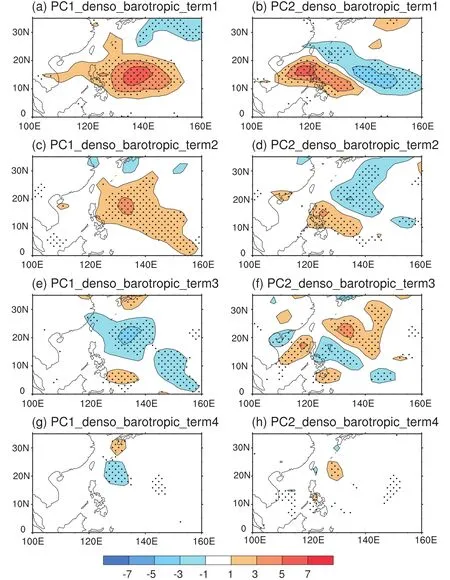
Fig.10.Regression of(a,b)term 1,(c,d)term 2,(e,f)term 3,and(g,h)term 4,with respect to the normalized(a,c,e,g)PC1_denso and(b,d,f,h)PC2_denso.Dots denote regions significant at the 95%confidence level.Units:10?6 m2s?3.
Both modes are associated with lower-level cyclonic anomalies.These cyclonic anomalies appear over different locations for the two modes:over the subtropical WNP for the first mode and over the SCS for the second mode.In addition,both modes are related to a significant zonal wind anomaly over the equatorial Pacific,consistent with the close relationship between these modes and ENSO.The correlation coefficients between the PC1/PC2 and Ni?o3.4 index are significant but with opposite signs.We remove the components related to ENSO and further examine the leading modes.The results show that,after removing the effect of ENSO,the two leading modes are very similar to those obtained from the original data,albeit explaining slightly less of the variance.In addition,these two modes are associated with the local cyclonic anomalies in the lower troposphere—similar to the results obtained from the original data.The energetic analysis suggests that the meridional shear of the zonal wind associated with the cyclonic anomaly—particularly in the western part of the WNP—plays a dominant role in the barotropic kinetic energy conversion from mean flow to eddy flow,which maintains the leading modes.
Acknowledgements.We thank the two anonymous reviewers for their comments,which were very helpful for improving the presentation of this paper.This work was supported by the National Natural Science Foundation of China(Grant Nos.41320104007,41475074 and 41475077).
Cao,X.,P.Huang,G.H.Chen,and W.Chen,2012:Modulation of western North Pacific tropical cyclone genesis by intraseasonal oscillation of the ITCZ:A statistical analysis.Adv.Atmos.Sci.,29,744–754,https://doi.org/10.1007/s00376-012-1121-0.
Chan,J.C.L.,and K.S.Liu,2004:Global warming and western North Pacific typhoon activity from an observational perspective.J.Climate,17,4590–4602,https://doi.org/10.1175/3240.1.
Chen,G.H.,and R.H.Huang,2009:Interannual variations in mixed Rossby-gravity waves and their impacts on tropical cyclogenesis over the western North Pacific.J.Climate,22,535–549,https://doi.org/10.1175/2008JCLI2221.1.
Chen,G.H.,and C.Chou,2014:Joint contribution of multiple equatorial waves to tropical cyclogenesis over the western North Pacific.Mon.Wea.Rev.,142,79–93,https://doi.org/10.1175/MWR-D-13-00207.1.
Chen,T.-C.,J.-D.Tsay,M.-C.Yen,and J.Matsumoto,2012:Interannual variation of the late fall rainfall in central Vietnam.J.Climate,25,392–413,https://doi.org/10.1175/JCLI-D-11-00068.1.
Fu,B.,T.Li,M.S.Peng,and F.Z.Weng,2007:Analysis of tropical cyclogenesis in the western North Pacific for 2000 and 2001.Wea.Forecasting,22,763–780,https://doi.org/10.1175/WAF1013.1.
Fukutomi,Y.,C.Kodama,Y.Yamada,A.T.Noda,and M.Satoh,2016:Tropical synoptic-scale wave disturbances over the western Pacific simulated by a global cloud-system resolving model.Theor.Appl.Climatol.,124,737–755,https://doi.org/10.1007/s00704-015-1456-4.
Hsu,P.-C.,C.-H.Tsou,H.-H.Hsu,and J.H.Chen,2009:Eddy energy along the tropical storm track in association with ENSO.J.Meteor.Soc.Japan,87,687–704,https://doi.org/10.2151/jmsj.87.687.
Hsu,P.-C.,T.Li,and C.-H.Tsou,2011:Interactions between boreal summer intraseasonal oscillations and synoptic-scale disturbances over the western North Pacific.Part I:Energetics diagnosis.J.Climate,24,927–941,https://doi.org/10.1175/2010JCLI3833.1.
Huang,P.,and R.H.Huang,2011:Climatology and interannual variability of convectively coupled equatorial waves activity.J.Climate,24,4451–4465,https://doi.org/10.1175/2011 JCLI4021.1.
Hurley,J.V.,and W.R.Boos,2015:A global climatology of monsoon low-pressure systems.Quart.J.Roy.Meteor.Soc.,141,1049–1064,https://doi.org/10.1002/qj.2447.
Kuo,H.-C.,J.-H.Chen,R.T.Williams,and C.-P.Chang,2001:Rossby waves in zonally opposing mean flow:Behavior in northwest Pacific summer monsoon.J.Atmos.Sci.,58,1035–1050,https://doi.org/10.1175/1520-0469(2001)058<1035:RWIZOM>2.0.CO;2.
Lau,K.-H.,and N.-C.Lau,1992:The energetics and propagation dynamics of tropical summertime synoptic-scale disturbances.Mon.Wea.Rev.,120,2523–2539,https://doi.org/10.1175/1520-0493(1992)120<2523:TEAPDO>2.0.CO;2.
Li,R.C.Y.,and W.Zhou,2012:Changes in western Pacific tropical cyclones associated with the El Ni?o-Southern Oscillation cycle.J.Climate,25,5864–5878,https://doi.org/10.1175/JCLI-D-11-00430.1.
Maloney,E.D.,and D.L.Hartmann,2001:The Madden-Julian oscillation,Barotropic dynamics,and North Pacific tropical cyclone formation.Part I:Observations.J.Atmos.Sci.,58,2545–2558,https://doi.org/10.1175/1520-0469(2001)058<2545:TMJOBD>2.0.CO;2.
Maloney,E.D.,and M.J.Dickinson,2003:The intraseasonal oscillation and the energetics of summertime tropical western North Pacific synoptic-scale disturbances.J.Atmos.Sci.,60,2153–2168,https://doi.org/10.1175/1520-0469(2003)060<2153:TIOATE>2.0.CO;2.
Molinari,J.,and D.Vollaro,2013:What percentage of western North Pacific tropical cyclones form within the monsoon trough?Mon.Wea.Rev.,141,499–505,https://doi.org/10.1175/MWR-D-12-00165.1.
North,G.R.,T.L.Bell,R.F.Cahalan,and F.J.Moeng,1982:Sampling errors in the estimation of empirical orthogonal functions.Mon.Wea.Rev.,110,669–706,https://doi.org/10.1175/1520-0493(1982)110<0699:SEITEO>2.0.CO;2.
Serra,Y.L.,G.N.Kiladis,and M.F.Cronin,2008:Horizontal and vertical structure of easterly waves in the Pacific ITCZ.J.Atmos.Sci.,65,1266–1284,https://doi.org/10.1175/2007 JAS2341.1.
Sobel,A.H.,and C.S.Bretherton,1999:Development of synoptic-scale disturbances over the summertime tropical northwest Pacific.J.Atmos.Sci.,56,3106–3127,https://doi.org/10.1175/1520-0469(1999)056<3106:DOSSDO>2.0.CO;2.
Tsou,C.-H.,H.-H.Hsu,and P.-C.Hsu,2014:The role of multiscale interaction in synoptic-scale eddy kinetic energy over the western North Pacific in autumn.J.Climate,27,3750–3766,https://doi.org/10.1175/JCLI-D-13-00380.1.
Webster,P.J.,and H.-R.Chang,1988:Equatorial energy accumulation and emanation regions:Impacts of a zonally varying basic state.J.Atmos.Sci.,45,803–829,https://doi.org/10.1175/1520-0469(1988)045<0803:EEAAER>2.0.CO;2.
Wu,L.,Z.P.Wen,R.H.Huang,and R.G.Wu,2012:Possible linkage between the monsoon trough variability and the tropical cyclone activity over the western North Pacific.Mon.Wea.Rev.,140,140–150,https://doi.org/10.1175/MWR-D-11-00078.1.
Wu,L.,Z.P.Wen,T.Li,and R.H.Huang,2014:ENSO-phase dependent TD and MRG wave activity in the western North Pacific.Climate Dyn.,42,1217–1227,https://doi.org/10.1175/MWR-D-11-00078.1.
Wu,L.,Z.P.Wen,and R.G.Wu,2015a:Influence of the monsoon trough on westward-propagating tropical waves over the western North Pacific.Part I:Observations.J.Climate,28,7108–7127,https://doi.org/10.1175/JCLI-D-14-00806.1.
Wu,L.,Z.P.Wen,and R.G.Wu,2015b:Influence of the monsoon trough on westward-propagating tropical waves over the western North Pacific.Part II:Energetics and numerical experiments.J.Climate,28,9332–9349,https://doi.org/10.1175/JCLI-D-14-00807.1.
Xu,Y.M.,T.Li,and M.Peng,2013:Tropical cyclogenesis in the western North Pacific as revealed by the 2008-09 YOTC data.Wea.Forecasting,28,1038–1056,https://doi.org/10.1175/WAF-D-12-00104.1.
 Advances in Atmospheric Sciences2018年5期
Advances in Atmospheric Sciences2018年5期
- Advances in Atmospheric Sciences的其它文章
- Analysis of the Characteristics of Inertia-Gravity Waves during an Orographic Precipitation Event
- Geometric Characteristics of Tropical Cyclone Eyes before Landfall in South China Based on Ground-Based Radar Observations
- Characteristics and Preliminary Causes of Tropical Cyclone Extreme Rainfall Events over Hainan Island
- Numerical Study of the Influences of a Monsoon Gyre on Intensity Changes of Typhoon Chan-Hom(2015)
- The 30–60-day Intraseasonal Variability of Sea Surface Temperature in the South China Sea during May–September
- Organizational Modes of Severe Wind-producing Convective Systems over North China
